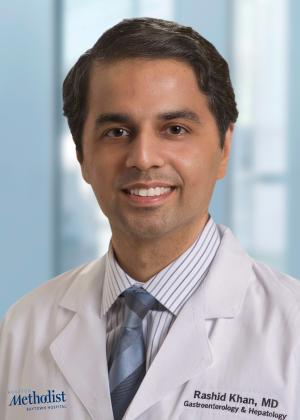Know Your Risk for Common Liver Disease
While it may strike without warning or symptoms, the condition known as nonalcoholic fatty liver disease (NAFLD) may lead to very serious consequences. A common disease impacting nearly 100 million Americans, the term nonalcoholic fatty liver disease describes a range of liver conditions affecting people who drink little to no alcohol. The main characteristic of NAFLD is that too much fat is stored in liver cells.
Dr. Rashid Khan, a gastroenterologist/hepatologist with Houston Methodist Gastroenterology Associates in Baytown, says while the exact cause of the condition is difficult to pinpoint, knowing your risk is vital.
“The condition may be diagnosed in people representing every age group, but it is especially prevalent in people in their 40s and 50s who are at high risk of heart disease due to the presence of such risk factors as obesity and type 2 diabetes” Khan said. “The condition is also closely linked to metabolic syndrome, a cluster of abnormalities including increased abdominal fat, poor ability to use the hormone insulin, high blood pressure and high blood levels of triglycerides.”
Khan identifies five reasons why NAFLD should be taken seriously:
•The most relevant reason is the potential transformation of fatty liver disease to liver cirrhosis. “Fatty liver is generally benign, but the development of cirrhosis becomes a game changer,” Khan said.
•Along with the potential risk of cirrhosis comes the added risk of developing liver cancer. Studies have shown that this risk is even present without cirrhosis.
•Cardiovascular disease (CVD) is one of the most common medical conditions in the U.S.; it goes hand in hand with NAFLD. “Usually, both exist in many patients. Fatty liver is known to be an independent predictor of CVD,” he says.
•Numerous studies have shown the likelihood that diabetic patients eventually develop NAFLD. “This association is bi-directional, in that some patients with fatty liver will go on to develop diabetes,” Khan said.
•A link between chronic kidney disease (CKD) and NAFLD has been identified. While the association of NAFLD and CKD may not be as robust as with CVD and diabetes, it may be
tied to metabolic syndrome, which involves dangerous plaque build-up in the blood vessels throughout the body.
While the onset of nonalcoholic fatty liver disease frequently does not include signs and symptoms, when symptoms are present, they may include:
•Enlarged liver •Fatigue •Pain in the upper right abdomen
Khan says lowering your risk for developing NAFLD can be achieved through choosing a healthy diet rich in fruits, vegetables, whole grains and healthy fats, maintaining a healthy weight and getting regular exercise. The first line of treatment generally involves weight loss through eating a healthy diet and exercising regularly. However, weight-loss surgery may be an option for those who are morbidly obese.
Because symptoms may not be present, Khan says regular screenings, including blood and liver enzyme and function tests, may effectively detect the disease in its earliest stages.
If you want to learn more about liver issues, Dr. Khan is speaking at a virtual event hosted by the Texas Liver Foundation on October 25 from 11 a.m. to noon. To register, scan the QR code below, or visit texasliverfoundation.org/event/fatty-liver-disease-webinar.


